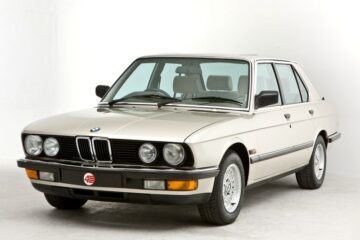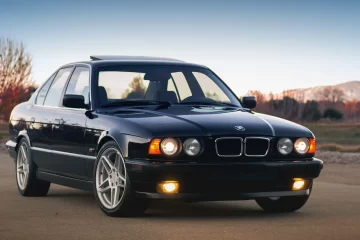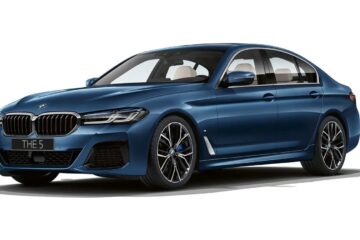The introduction of the BMW 5 E12 to the public took place in 1972, immediately after the end of the Olympic Games and in the same city where the biggest sporting events of the quadrennium were held. The people of Munich and its guests saw the car at the motor show. It was a response to its main competitor, Mercedes, which launched the W114 sedan in 1968. Interestingly, the design of both cars was developed by the same specialist, Paul Braque. The Frenchman worked for Mercedes, and then moved to BMW.
The car was produced in Europe until 1981, and finally production stopped 3 years later in South Africa. The number of produced cars reached almost 700 thousand units.
Appearance
“The 1st generation Five is a premium sedan. At first, its hood was flat. Then it began to be covered by a brightly colored stamping of the engine compartment. The middle of the sedan protrudes above the other surface. This is clearly visible on the photo of BMW E12. In order for the vehicle to have good aerodynamics, the specialists of the concern gave the body a negative slope.
The car, weighing between 1.24-1.41 tons, has average dimensions: length was 4.62 meters, width – 1.69 meters, height – 1.425 meters. The ground clearance of the sedan is 140 mm.
The car delivered to the North American market had enlarged turn signals on the fenders. In addition, it was fitted with massive and reinforced bumpers, preventing damage to the car in collisions at speeds up to 10 km/h.
Interior
At the time of BMW E12 production, the interior of the car looked modern and even revolutionary. The interior floor was decorated with high-wool carpets. The dashboard of BMW E12 had black color, and in contrast with chairs/doors with light upholstery it looked spectacular. That it was a great design decision can be judged by the interior of modern cars of the automaker. Almost half a century has passed, and the specialists of the concern do not think to give up this color solution.
And in the interior, models delivered to the American continent differed from cars intended for sale elsewhere. The list of options was extensive. One might note:
- The interior is wood trimmed with leather;
- Light alloy disks;
- Self-locking differential;
- A good stereo system. Even in base, it was powerful;
- Power panoramic sunroof and power mirrors with glass;
- Air conditioning system.
Equipment
There were many innovations available on the first generation model.
For the first time, the Concern’s cars have connectors for connecting equipment for system diagnostics. A small flashlight was installed in the glove compartment, and a box in the trunk. A set of tools will never be superfluous on the road.
Of the other innovations worth noting:
- Power steering;
- Radiator mounted on elastic supports;
- Aft shock absorbers inside the springs, giving you the option to mount the suspension with auto-clearance.
Technical specifications
Let’s break down what the BMW E12’s technical specifications are.
The traction of the engines has always been excellent, so BMW cars stood out on the roads with excellent dynamic qualities. Hence the 240 km/h mark on the speedometer of the E12. The BMW’s rear reaction thrust was amazing. It provided stability to the car and corrected the work of the clutch. The first models among the cars of the 1st generation were BMW E12 520/520i. The sedans were equipped with two-liter four-cylinder M10 powerplants. On the first car – with carburetor feeding, on the second – distributed fuel injection with a fuel injection system.
The power of the 520/520i sedan was 115/125-130 hp. Therefore, the first/second car accelerated to a “hundred” in 12.3/11.3 sec, the maximum speed reached 173/183 km/h, and the average fuel consumption per 100 km was 10.7/9.5 liters. A year later BMW 525 E12 with a six-cylinder engine M30B25 appeared. Volume – 2.5 liters, power – 145-150 “horses”. Acceleration took 10.1 seconds, speed limit – 193km/h, fuel consumption – 10.5 liters /100 km.
Then the energy crisis broke out in Europe, which affected Germany and BMW. The concern decided to produce economical variants of the sedan, BMW E12 518/518i, and complete them with 90/100-horsepower powerplant M10B18 with a volume of 1.8 l. The difference in characteristics was minimal. The first/second car accelerated in 13.9/14.2 sec, top speed was 160/167 km/h, average fuel consumption – 9.5/10.6 liters.
As soon as the crisis passed, the expensive BMW E12 528i model appeared on the market. The car with a 2.8-liter six-cylinder gasoline engine and 184 hp could accelerate in 9.3 seconds and move on the highway at a speed of up to 207 km/h, consuming up to 10.6 liters of fuel per 100 km. The most rapid model (222 km/h) was BMW M535i E12, equipped with a power plant M30B34. It was created jointly with the Motorsport division.
The volume of BMW E12 M535 3.5 liters, power – 218 “horses”. The arrow on the speedometer reached the mark at 100 km/h in 7.5 sec. gasoline consumption, on average, 10.6 liters.
All models were equipped with manual gearboxes with 4/5 gears. Option – transmission with short/long gears for sporty/economical driving. Later, a three-stage “automatic” replaced the MKPP.
Finally, how much oil is required for E12 motors? 4 liters.
Difference between restyling and prerestyling
A large-scale restyling of the “Five” of the first generation took place in the year of the Montreal Olympics. In 1976, the concern engineers changed more than 40 units/details, modernized the interior of the sedan with its exterior.
At the front, the hood has acquired the trademark stamping, overhanging the radiator grille, which was slightly shifted upwards. Large-size brake lights appeared at the stern. The gas tank neck was moved to the rear fender.
A new steering wheel was installed in the sedan’s interior, and a sensor that monitors pad wear was installed on the disc brakes.
Tuning
In 70-80 years there was a famous special division Motorsport. It prepared modifications of the 525 and 528 to meet the wishes of a particular customer. It was this division that showed the public in 1980 a sedan M535i with an M30 engine. The engine with a volume of 3.5 liters and a power of 218 “horses”, accelerated the car to 240 km/h, and it took 7.2 seconds to reach a hundred.
The sedan was equipped with Recaro/ASS seats, a 5-speed sport transmission, a self-locking differential and suspension with Bilstein shock struts.
Two years earlier, the public had seen the Alpina cars at the Frankfurt Motor Show. Among them was the Alpina B7 Turbo sedan, the basis of which was the 528i. 300 “horses” allowed the car to reach 240 km/h. In the 70s, this car was the fastest in the sedan class. The basic equipment of the car consisted of R16 wheels, Pirelli P7 tires, Bilstein shock absorbers, ventilated disc brakes, Pioneer stereo system.
Many fans of the Bavarian concern’s cars take BMW E12 and do tuning. If you are one of them, you should know. That most of the parts on this sedan are not produced, and individual parts cost fabulous money. We recommend to look their cost in the network and estimate, whether you will pull tuning and the subsequent maintenance of the car.
In the end, we will say that in 1981, the E12 gave way on the conveyor belt to the cars of the second generation, the E28
models. However, you can meet cars of 1982, because these sedans until 1984 were produced in South Africa. The cars were so popular that in 1980 norev models appeared. These are metal car toy companies making exact replicas of cars in 1:43 or 1:18 scale.
Generations and configurations
Sedan 1st generation – restyled
08.1976 – 06.1981
| 518 AT | M10B18 | 1.8L | 90 hp |
| 518 MT | M10B18 | 1.8L | 90 hp |
| 520/4 MT | M10B20 | 2.0L | 115 hp |
| 520/4 AT | M10B20 | 2.0L | 115 hp |
| 520/6 AT | M20B20VE | 2.0L | 122 hp |
| 520/6 MT | M20B20VE | 2.0L | 122 hp |
| 520i MT | M10B20 | 2.0L | 125 hp |
| 525 MT | M30B25 | 2.5L | 150 hp |
| 525 AT | M30B25 | 2.5L | 150 hp |
| 528 MT | M30B28 | 2.8L | 170 hp |
| 528 AT | M30B28 | 2.8L | 170 hp |
| 528i AT | M30B28LE | 2.8L | 177 hp |
| 528i MT | M30B28LE | 2.8L | 177 hp |
| 528i MT | M30B28LE | 2.8L | 184 hp |
| 528i AT | M30B28LE | 2.8L | 184 hp |
| M 535i MT | M30B35LE | 3.5l | 218 hp |
Sedan 1st generation
08.1972 – 07.1976
| 518 MT | M10B18 | 1.8L | 90 hp |
| 520/4 MT | M10B20 | 2.0L | 115 hp |
| 520/4 AT | M10B20 | 2.0L | 115 hp |
| 520i MT | M10B20 | 2.0L | 130 hp |
| 525 MT | M30B25 | 2.5L | 145 hp |
| 525 AT | M30B25 | 2.5L | 145 hp |
| 528 MT | M30B28 | 2.8L | 165 hp |
| 528 AT | M30B28 | 2.8L | 165 hp |



0 Comments